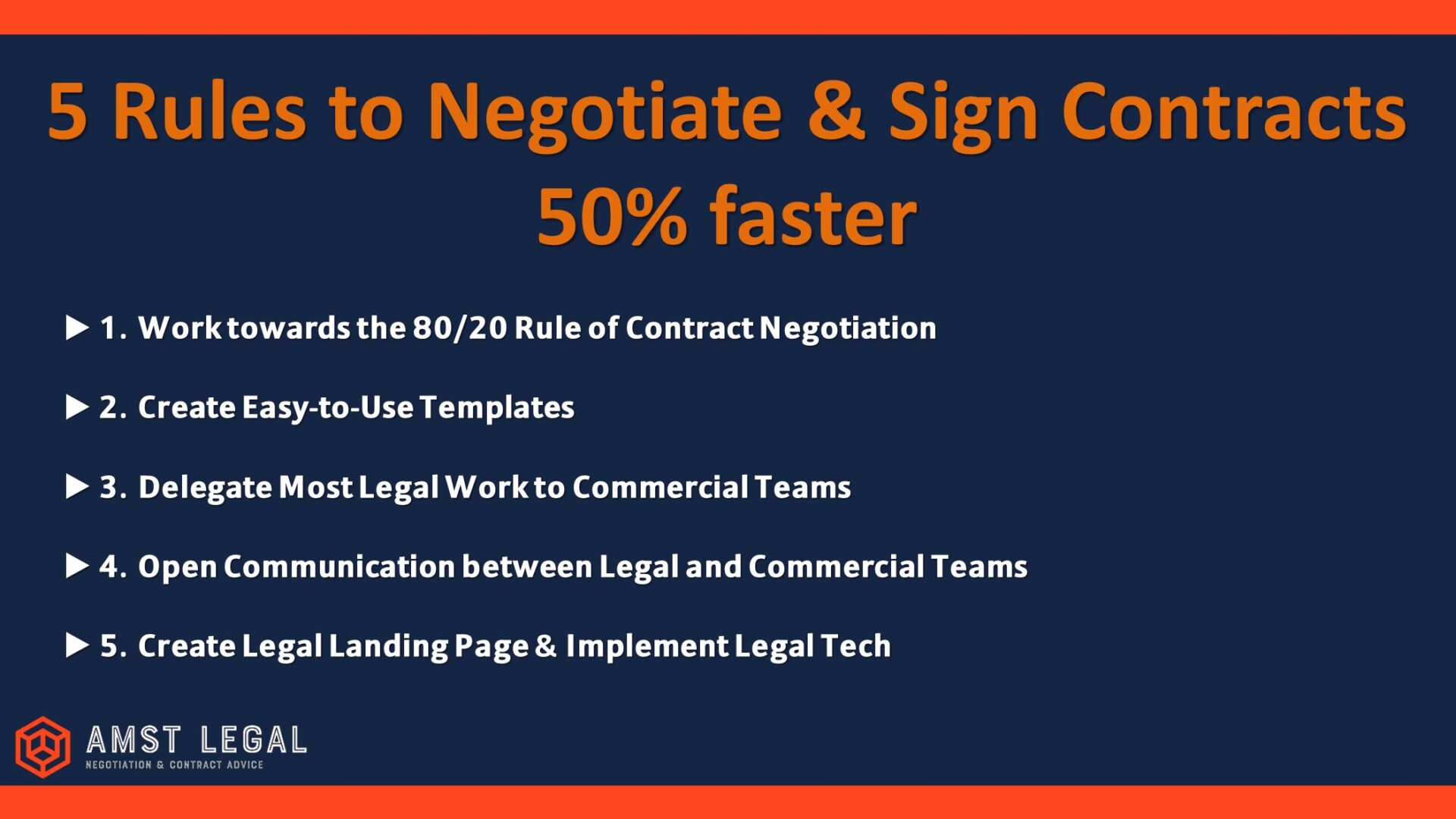
In the Press: A Conversation with Robby Reggers (English)
In The Press: Dutch Interview with mr-online – legal platform

How to Negotiate Contracts Faster Before Q3 Ends
Are you struggling to get your contract signed before Q3? As someone who has been working in contract law since 2004, I understand how stressful the last week of the quarter can be. You’re trying to close deals, manage client expectations and meet internal deadlines. Over the years, I’ve refined a few strategies to help speed up the process and keep things moving smoothly during this critical period.
In this article ‘How to Close Contracts Fast Before Q3 Ends’ (a follow up on this article), I will share practical tips I’ve gathered throughout my career.
This will help you negotiate and close your contracts before Q3 ends – whether you’re a legal professional or part of the sales / procurement team.
1. Groundwork: Setting the Foundation for Smooth Contract Closures
Before we get into the last-minute strategies, it’s important to acknowledge that no matter how prepared you are in the final week of the quarter, the real work begins long before that. Over the months leading up to these peaks, the following foundation should be laid out – so you can negotiate contracts faster (and better), and act quickly & decisively when time is of the essence.
The four pillars of better contract processes, developed by AMST Legal, are:
# Create Standard Templates
One of the simplest yet most effective ways to streamline the contract process is to use standardized templates. As I also wrote in this article, when teams work with simple, pre-approved, consistent language, it cuts down on back-and-forth reviews and will greatly improve contract negotiations. You will know exactly what is in each contract, with the right risk profiles and internal teams are trained on using it. If your organization doesn’t already have these, make creating them a priority for the future. It will be a game-changer for your company.
# Set Minimum Value Limits for Negotiations
During these peaks, it will be impossible for legal to help out the commercial teams and review & negotiate all contracts. It is therefore important that teams use the standard templates as much as possible. A great tool for this is setting agreed minimum contract value in the company, also see this article by Ironclad on this subject. For smaller contracts, also consider limiting negotiation points or automating approvals for low-risk items. This has saved me countless hours over the years and allows legal teams to focus on more complex, high-value contracts.
# Improve Internal Communication and Training
Lack of communication is often the reason of delayed contracts. By establishing clear communication channels between legal, sales and management teams, you can avoid last-minute surprises. Regular training sessions also ensure that everyone understands the process and the contract standards, which makes a huge difference when things get hectic at the end of the quarter. Consequently, internal teams will feel more confident when negotiating contracts.
# Implement Legal Tech Solutions
If you set up the above, but processes still need to be improved due to a high volume of contracts, it’s time to embrace legal tech solutions. Tools like e-signature, contract management or AI Contract Review can significantly speed up your workflow and will help you negotiate contracts faster. I’ve seen contracts get stuck for days simply because (i) someone was out of the office and couldn’t physically sign a document or (ii) we couldn’t find the relevant document to sign
2. Prioritize High-Volume and Strategic Deals
As the quarter draws to a close, it’s time to get laser-focused. You simply can’t negotiate all contracts at once, and that is perfectly normal. The key is to prioritize high-volume or strategically important deals. This is where you will get the most return on your time investment.
How to Identify Key Deals
I always ask myself (and my team) two questions at this stage:
- Is this contract actually closing by the end of Q3?
- Is this a high-volume or high-value deal?
If a contract doesn’t meet these criteria, it’s not worth your time right now. You will waste valuable energy chasing and negotiating contracts that can be closed after the quarter ends. Focus on what you can (and must) win now, and push the rest to next quarter.
Managing Distractions
Distractions are everywhere, especially when the pressure is on. This is the time to train yourself (and your team) to stay focused. Make sure everyone is crystal clear: the goal is to close and only negotiate Q3 contracts, nothing else. If it’s not urgent or relevant to Q3, it can wait. This might seem obvious, but it’s surprising how many teams get sidetracked by low-priority tasks during this crunch time.
3. Clear Communication with Clients and Teams
Communication is critical at every stage of a contract negotiation, but it becomes especially clear when deadlines are looming. You need to maintain transparent, open lines of communication – both internally and with your clients.
External Communication
Clients don’t always understand the urgency we feel in the final week of the quarter. That’s why I make it a point to confirm their needs early on, well before the last-minute rush. I’ve found that directly addressing concerns and reiterating the importance of deadlines can push things along. Clients are more likely to act quickly when they understand the background.
If you sense a deal might be slipping to the next quarter, reach out to your client immediately. Often, an honest conversation can be the difference between closing a deal on time or missing the deadline.
Internal Communication
In a busy period like this, internal communication is just as crucial. Make sure your teams are aligned, especially if multiple departments are involved. The last thing you want is a delay because someone missed an internal approval. I usually recommend daily check-ins or updates to keep things moving.
And if a deal is stuck, escalate quickly. There’s no time for prolonged delays when the quarter is on the line.
4. Encourage Team Collaboration
Complex contracts can’t be handled alone – negotiating contracts is a team sport. I’ve learned over the years that collaboration is the key to overcoming obstacles, especially when time is running out.
Breaking Down Silos
Avoid the temptation to work in silos, especially on tricky deals. Bring in your legal, sales, finance, and operations teams as needed. Each department offers a unique perspective that can help you get past obstacles faster. In many cases, a quick group discussion can solve a problem that might take one person days to figure out on their own.
Address Escalation Matters
If a contract is stuck in escalation, resolve it now. Whether it’s a pricing issue or compliance matter, gather the right people and tackle it head-on. Waiting for someone else to make the call will only waste time.
5. Deadline Management
Nothing is more frustrating than having a contract fall through because of a missed deadline. In the final days of the quarter, every deadline matters – whether it’s a signature, a document approval or a client review.
Plan Ahead
Two of the best pieces of advice at the end of a contract negotiation: 1. ask the counterparty how many days they need to get the document signed. Are there internal processes we need to think of? and 2. plan a few days ahead. You never know what might come up in the final days & hours, so giving yourself a bit of extra time can help prevent last-minute panic. Make sure signatures are collected and documents are finalized before the last day of the quarter, whenever possible.
Avoid Costly Mistakes
Missing a deadline – even a minor one – can push a deal into the next quarter. Not only is this frustrating, but it can also have financial implications for your business. Stay on top of dates, and build in extra time for any last-minute reviews or approvals that might come up.
6. Frequently Asked Questions (FAQs)
Q1. What should I do if a deal is unlikely to close by the end of the quarter?
If a deal isn’t likely to close by the end of Q3, communicate it to the relevant teams and deprioritize it. Focus on deals that have a real chance of closing now. Set expectations with clients for the next quarter and move forward.
Q2. How can I speed up communication between teams?
Hold daily check-ins and use tools like Slack or Microsoft Teams to facilitate quick communication. This ensures everyone is aligned and up-to-date on contract status.
Q3. What legal tech tools should I use?
I highly recommend e-signature platforms, Contract Management / Contract Lifecycle Management Tools and AI Review Tools. These tools reduce delays, help automate workflows and make the signing process smoother.
Q4. Should I negotiate terms at the last minute?
This is a subject for a longer article, but at this stage, avoid extensive negotiations. If terms are still being discussed, escalate the decision or consider finalizing the contract as-is and revisiting the terms in the next quarter.
Q5. How do I ensure my team stays focused?
Keep the team aligned on priorities. Regular check-ins can help ensure everyone is working toward the same goal: closing Q3 deals. Delegate non-urgent tasks to be handled after the quarter ends.
Conclusion
As a legal professional that has been through countless quarter-end rushes, I know how stressful it can be. But by following the tips in this article ‘How to Close Contracts Faster Before Q3 End’ will help. Focus on the right deals, maintain clear communication and keep your team aligned. This way, you can close more contracts before Q3 ends. Stay organized, be proactive and you will be able to meet your goals without the last-minute panic.
If you follow these tips, you’ll not only survive the end-of-quarter peak, but you’ll also set yourself up for success in the quarters to come.
Please reach out to us via +31650608964 or send an email to lowa@amstlegal.com if you need more information or advice about this subject.

Three Critical Elements of the new NBA Broadcasting Negotiation Explained
What is the NBA TV Deal About?
The NBA’s recent 11 year – $77 billion – broadcasting deal is a monumental shift in sports media, showcasing the complexities and high-stakes nature of modern contract negotiations. In this article ‘Three Critical Elements of the new NBA Broadcasting Negotiation Explained’ we will summarize what the NBA high stake negotiation is about.
This agreement with ESPN, NBC, and Amazon Prime Video. starting in the 2025-226 season, redefines how fans will engage with the sport. However, this NBA Broadcasting Negotiation also introduces significant legal challenges from TNT Sports. Let’s delve into the details of this historic deal and the ensuing legal battle.
Three Critical Elements of the new NBA Broadcasting Negotiation Explained
The new agreements of the NBA (including the WNBA) will be for 11 years and includes the following key partnerships:
- ESPN/ABC: Continuing as the home for the NBA Finals, with extensive coverage of regular-season and playoff games.
- NBC: Returning to NBA broadcasting, showing regular-season games, playoff matchups and the All-Star Game.
- Amazon Prime Video: Introducing a streaming-only package that covers critical playoff games, regular-season action and the In-Season Tournament.
As a result, this new approach aims to leverage diverse platforms to maximize fan engagement and accessibility. Looking at the size of these high-stake negotiations, the teams involved were skilled contract negotiation experts that we can learn from.
TNT Sports’ Legal Challenge
TNT Sports, a longstanding NBA broadcasting partner, does not agree with the new agreements. To summarize, it claims that it has a contractual right to match the terms of the new agreements. TNT will face the following legal challenges:
- Broadcasting Platforms: First, TNT’s contract contains both cable and streaming options, where Amazon’s offer is exclusively streaming-based.
- Audience Reach: Next, Amazon’s platform offers a broader audience reach than TNT.
- Financial Terms: Finally, Amazon’s upfront payment contrasts with TNT’s proposed line of credit, reflecting different financial strategies.
This disagreement underscore the evolving landscape of sports broadcasting rights and the complexities involved in negotiating such high-stakes deals.
Potential Legal Outcomes
In essence, the lawsuit from TNT could result in several potential outcomes:
- Extended Negotiations: Both parties might seek to renegotiate terms to avoid the complications and public scrutiny of a court case.
- Compromise Solutions: Additionally, possible adjustments to the agreements or financial settlements could resolve the dispute.
- Industry Precedents: Lastly, the resolution of this case could set significant precedents for future sports broadcasting contracts and disputes.
Implications for the Future
The NBA’s new broadcasting agreements highlight the increasing importance of digital platforms in reaching global audiences. By partnering with ESPN, NBC, and Amazon, the NBA aims to enhance the fan experience through more diverse viewing options and innovative content delivery.
However, the legal challenge from TNT Sports could delay or change the implementation of these deals. As both sides prepare for a potential courtroom battle, the sports media industry will be closely watching the outcome, which could influence the future of sports broadcasting negotiations.
The Importance of Well-Crafted Contract Negotiations
This case highlights how critical well-crafted contract negotiations are. Not just in high-stakes sports deals like this, but in everyday business transactions.
Even billion-dollar deals aren’t immune to contract disputes or legal battles. The NBA’s recent broadcasting agreement proves that clear language is crucial, no matter the stakes.
This underscores the need for clear, precise language and comprehensive terms in contracts to minimize misunderstandings and legal disputes.
In addition, from business agreements to personal contracts, the principles of clear communication and mutual understanding are vital. What we can learn from this case is that, as legal professionals, it is our goal is to draft agreements that withstand scrutiny and prevent conflicts. Parties should have a shared understanding of their rights and obligations.
Lessons for Everyday Negotiations
The key takeaways from this monumental NBA deal for our everyday lives.
- Clear and Precise Language: Ensure that all terms are clearly defined and agreed upon to avoid misunderstandings. This means that is it is important to use unambiguous contract language to prevent disputes.
- Consider All Platforms and Options: Just as the NBA considered both traditional and digital platforms to maximize reach, explore all available options and platforms in your negotiations to ensure the best possible outcomes for all parties involved.
- Financial Transparency and Stability: Financial terms should be transparent and feasible. he NBA preferred Amazon’s upfront payment over TNT’s line of credit, highlighting the need for clear and stable financial agreements in negotiations.
Conclusion
The NBA’s $77 billion broadcasting deal represents a significant milestone in sports media, reflecting the high-stakes nature of modern contract negotiations. Hopefully, this article ‘Three Critical Elements of the new NBA Broadcasting Negotiation Explained’ helped make clear why this deal is so important.
While the new agreements promise to enhance fan engagement and accessibility, the potential legal battle with TNT Sports adds a layer of complexity to the situation. As the story unfolds, it will provide valuable insights into the dynamics of sports broadcasting rights and the legal intricacies involved in negotiating such monumental deals.
By understanding the details and implications of this historic agreement, it will be easier to understand the evolving landscape of sports media and broadcasting. Also, this serves as a reminder of the importance of meticulous contract drafting and negotiation in avoiding costly legal disputes and ensuring smooth, successful partnerships.
Sources:
https://www.cnbc.com/2024/07/24/nba-picks-amazon-for-media-rights-over-warner-bros-discovery.html
https://www.nytimes.com/athletic/5655843/2024/07/24/nba-tnt-sports-tv-deal-match-rejected

Why Saying “That’s Right” Is a Great Negotiation Strategy
Introduction – Starting With The Basics
When negotiation, the ability to build trust and rapport with your counterpart is of huge importance. It should be part of any successful negotiation strategy. Negotiations are about connections between people, so do not loose sight of this when negotiating prices or a contract. See this article for more tips on live negotiations.
Do not forget is it even one of the basic principles of the Harvard Negotiation Principles. When building this connection with your counterpart, it is one of your best strategies to achieve a “that’s right” reaction from the other party. This simple yet powerful affirmation can significantly shift the dynamics of a negotiation in your favor as your counterparty will feel heard and understood, which will in turn lead to a better negotiation.
Getting to the “That’s Right” Moment
As we have seen in daily practice, and as highlighted by Chris Voss in his book “Never Split the Difference, one of the most effective strategies to building rapport is the art of eliciting a “that’s right” moment from the other party.
To be successful in receiving or giving this reaction, you will need to actively listen, empathize, and demonstrate a deep understanding of their position. By using techniques like mirroring, labelling or paraphrasing, you can set out the foundation to make the counterpart more receptive. This acknowledgment can break down barriers and invite a more honest and cooperative dialogue. It shows the other party that you value their perspective, resulting to a more collaborative negotiation process.
Building Trust and Understanding
In negotiations, achieving a “that’s right” moment means that the other party feels heard and understood. This feeling of being understood is a fundamental human need and, when met, can transform the negotiation landscape. When the other party says, “that’s right,” it indicates that you have accurately captured their concerns, desires, and motivations. This not only builds trust but also encourages them to be more open and flexible in finding a mutually beneficial solution.
The Power of Admitting Mistakes
At AMST Legal we even go further: you should also actively work towards saying ‘that’s right’ to your counterparty. Admitting that the counterparty made a good point or that she found an error in one of your documents is a powerful message.
Gaining Respect and Trust
Admitting mistakes and acknowledging the validity of the other party’s points is a powerful tool in negotiations. When you say “that’s right”, you show that you are not just in it to win but are also willing to concede and find common ground. As I have seen in a number of negotiations, this approach can disarm even the toughest negotiators and build a foundation of mutual respect and trust.
Don’t be hesitant admitting that your counterparty made a good point. At AMST Legal we say: works towards it!
Why admitting great point is a great negotiation Strategy
This vulnerability can humanize you in the eyes of the other party, making them more likely to trust and respect you. This, in turn, can lead to smoother negotiations and better outcomes for both sides.
Practical Strategies for Implementing “That’s Right”
To effectively use the “that’s right” negotiation strategy, consider the following practical steps:
- Active Listening: Truly listen to the other party without preparing your counterarguments in your head. Show that you understand by summarizing their points accurately. This involves not just hearing their words but also understanding their underlying concerns and motivations.
- Empathy Statements: Use phrases like “I understand how you feel” or “It sounds like…” to convey empathy and acknowledgment. These statements can help the other party feel validated and understood, which can reduce tension and foster a more collaborative atmosphere.
- Reflect and Validate: Reflect on what the other party has said and validate their feelings and perspectives. This does not mean you agree, but that you understand. Validation can be a powerful tool in building rapport and trust, as it shows that you are paying attention and taking their concerns seriously.
- Admit Your Mistakes: If you realize you’ve made an error or there’s a valid point from the other side, acknowledge it openly. Saying “I was wrong” can be powerful when building trust. Admitting mistakes can also show that you are confident and secure enough to own up to your errors, which can enhance your credibility and respectability.
- Seek Win-Win Solutions: Frame your negotiations around finding mutually beneficial outcomes. Show that you’re willing to make concessions for the greater good of both parties. This approach can create a more positive and productive negotiation environment, where both sides feel like they are working towards a common goal.
Other Experts confirming this Strategy
In addition to Chris Voss in his book Never Split the Difference, other experts have emphasized the importance of trust and understanding in negotiations. Please see below a list of three other leading Negotiation Experts confirming this approach.
The 7 Habits of Highly Effective People
Stephen Covey discusses in his book the principle of “Seek First to Understand, Then to Be Understood” as a fundamental habit for effective interpersonal communication. This aligns perfectly with the concept of achieving “that’s right” moments by demonstrating genuine understanding and empathy.
“When you show deep empathy toward others, their defensive energy goes down, and positive energy replaces it. That’s when you can get more creative in solving problems.” – Stephen R. Covey. Read more about Covey’s principles at FranklinCovey.
Getting to Yes: Negotiating Agreement Without Giving In
Roger Fisher and William Ury highlight in their book that changed the world of negotiation the importance of separating people from the problem and focusing on interests rather than positions. Understanding the other party’s interests can lead to more effective and amicable negotiations.
“Understanding the interests behind the positions helps negotiators find common ground and create win-win solutions.” – Roger Fisher and William Ury. Learn more from the Harvard Negotiation Project.
How to Win Friends and Influence People
Dale Carnegie’s timeless advice on building relationships and influencing people underscores the power of making the other party feel valued and understood.
“The deepest principle in human nature is the craving to be appreciated.” – Dale Carnegie. Explore Carnegie’s teachings at Dale Carnegie Training.
Conclusion
At AMST Legal, we have witnessed firsthand how these strategies transform negotiations. By striving for “that’s right” moments and being willing to admit our own mistakes, we foster an environment of trust and respect. This approach not only smooths the negotiation process but often leads to more sustainable and satisfactory agreements for all parties involved.
Incorporating the “that’s right” strategy into your negotiation toolkit can significantly enhance your ability to build trust, foster cooperation, and achieve successful outcomes. It emphasizes the importance of understanding, empathy, and humility in negotiations, which are key components in building long-lasting and mutually beneficial relationships.

7 böcker för att förbättra dina förhandlingsfärdigheter
Inledning
Att förhandla är en färdighet som kommer lättare för vissa människor men kan verka svår för andra. Att lära sig hur man förhandlar kan öppna många dörrar av möjligheter och göra dig överlag mer lycklig och framgångsrik i livet. Ett sätt att börja lära sig hur man förhandlar är att fördjupa sig i några av de bästa böckerna om ämnet skrivna av experter. För att visa ett sätt att börja lära sig eller förbättra sina förhandlingstekniker presenterar denna artikel en lista med 7 böcker för att förbättra dina förhandlingstekniker, åtföljd av en kort sammanfattning av varje bok.
Fortsätt läsa artikeln för att få veta mer och kick-starta din resa i att lära dig förhandla eller fortsätta finslipa dina förhandlingstekniker. På AMST Legal hjälper vi företag att förhandla bättre, förhandla affärsavtal, kontrakt och lösa tvister.
Böcker vi rekommenderar
Det finns flertal böcker om att förhandla på marknaden vilket gör det svårt att veta var man ska börja. För att förenkla det har vi sammanställt en lista med 7 böcker för att förbättra dina förhandlingsfärdigheter. Böckerna hanterar olika aspekter av att förhandla som beskrivs nedan.
1. Getting to yes: Negotiating Agreement Without Giving In
(flera versioner finns, senaste är från 2011) av Roger Fisher, William Ury & Bruce Patton
Utgångspunkten för det nya och förbättrade sättet att förhandlade började vid förhandlingsprogrammet på Harvard Law School. Boken syftar till att identifiera en metod för att nå bra överenskommelser, dvs principstyrda förhandlingar eller intressebaserade förhandlingar. Metoden är indelad i fyra delar som är relevanta under hela förhandlingsprocessen.
Metodens fyra delar är följande:
- Separera människorna från problemet,
- Fokusera på intressen snarare än positioner,
- Generera en mängd olika alternativ innan man enas om en överenskommelse, och
- Insistera på att överenskommelsen baseras på objektiva kriterier.
Boken är utmärkt för att lära dig grunderna för att bli en bättre förhandlare.
2. Never Split the Difference – Negotiating as if your life depended on it
(2016) av Chris Voss and Tahl Raz
I Voss och Raz bidrag till en annan bok som lär ut förhandlingstekniker är målet också grundläggande förhandling. Innehållet härrör från Voss erfarenhet som gisslandförhandlare inom FBI, vilket är anledningen till att tipsen är baserade utifrån sådana situationer. Tipsen kan dock tillämpas generellt när man lär sig eller förbättrar sina förhandlingstekniker för andra ändamål.
Bokens huvudpunkter är följande:
- Lär från historien,
- Prioritera aktivt lyssnande,
- Visa empati och förståelse,
- Det stärkande ordet ”nej”,
- Kraften i formuleringen ”det stämmer”,
- Avslöja dolda behov genom icke-linjära förhandlingar,
- Ställ kalibrerande frågor,
- Förstå motpartens förhandlingsstil och hur man kategoriserar dem, och
- Omfamna det okända.
3. Good for you, Great for me: Finding the Trading Zone and Winning at Win-Win Negotiation
(2014) av Lawrence Susskind
Som Fisher och Ury argumenterar i sin banbrytande bok (Getting to Yes), går Susskind ett steg längre och fokuserar på så kallad ”win-win”-förhandling. Det syftar på hur de flesta förhandlingar utspelar sig, som ett sätt att nå en överenskommelse baserad på att hitta det mest fördelaktiga resultatet för båda parter. Susskinds bok syftar till att visa hur man kan bli vinnaren i win-win-förhandlingar, eftersom resultatet kan bli bättre än bra, vilket är målet med win-win-förhandlingar.
4. Getting to yes with yourself: How to Get What You Truly Want
(2016) av William Ury
Förhandlande är inte bara ett fenomen som uppstår i affärsförhandlingar mellan män i fina kostymer. Det kan lika gärna äga rum och vara av betydelse var som helst och för alla i deras dagliga liv när de interagerar med andra människor. Ury försöker förklara hur man förhandlar i olika sammanhang genom att fokusera på dig och dina handlingar, vilket kan vara det som saboterar goda resultat från förhandlingar i ditt dagliga liv. Hans mål är att undvika sådana fallgropar och säkerställa din framgång i livet.
5. Harvard Business Review (HBR) Guide to Negotiating
(2016) av Jeff Wess
Fortsättningsvis presenterar Weiss fler tips för att förhandla framgångsrikt samtidigt som relationen med den andra parten upprätthålls i alla situationer i ditt dagliga liv, oavsett situationen och den andra parten. Weiss pekar ut åtta områden som du kommer att få mer djupgående kunskap om och förbättra dina färdigheter om du gör följande:
- Identifierar de verkliga frågorna som står på spel,
- Förbereder material i förväg,
- Sätter rätt ton i början av samtalet,
- Hanterar känslor när du förhandlar,
- Tämjer en skicklig motpart,
- Vet när du ska avsluta,
- Hanterar förhandlingar mellan flera parter, och
- Säkerställer att ditt avtal är verklighetsförankrat.
6. Sign here: The enterprise guide to closing contracts quickly
(2021) av Alex Hamilton
När ditt mål är specifikt affärsrelaterat kan Hamiltons bok vara mer lämplig eftersom dess fokus ligger på den kommersiella kontraktsprocessen i samband med tekniska lösningar. Några insikter som du kan få mer djupgående kunskap om inkluderar:
- Vikten av tempo i kontraktsprocesser,
- Att det inte finns någon universallösning som passar för varje problem,
- Att förändringar tar tid,
- Hur du sätter tydliga och rimliga villkor, och
- Hur du ska prioritera.
Bokens grund kommer från Hamiltons praktiska erfarenhet inom området, vilket är varför den är utformad som en praktisk guide.
7. Contract Law – Text, Cases and Materials
(2014) by Ewan McKendrick
Sist men inte minst har vi McKendricks bok ”Contract Law” som i och för sig inte ger praktiska förhandlingstips. I stället täcker den relevanta juridiska insikter om t.e.x oskälig styrka mellan parterna. Sådana avtalsrättsliga regler är bra att känna till både för företag och privatpersoner, om du eller den andra parten kan anses vara starkare eller svagare. Om så är fallet finns det skyddande lagregler för att justera ojämlikheten i förhandlingsförhållandet.
Slutsats
Som presenterats i den här artikeln finns det olika typer av böcker om att förhandla som täcker olika områden. Detta utgör alltså bara en introduktion av vad som kan vara till hjälp när du lär dig eller förbättrar dina förhandlingsfärdigheter. Förhoppningsvis kan detta vara till nytta vid överväganden om val av bokinköp för att omfamna den effektiva och viktiga färdigheten att förhandla.
Om du behöver rådgivning, träning eller djupgående praktisk kunskap från en riktig förhandlingsexpert och avtalsrättsrådgivare, kontakta oss på AMST Legal.
Källor:
https://www.pon.harvard.edu/shop/good-for-you-great-for-me
https://lifeclub.org/books/getting-to-yes-with-yourself-william-ury-review-summary
https://www.vantagepartners.com/insights/hbr-guide-to-negotiating
https://www.lovelawrobots.com/five-things-i-wish-i-learnt-from-sign-here-by-alex-hamilton
https://www.ted.com/talks/simon_sinek_how_great_leaders_inspire_action?language=en
https://calvinrosser.com/notes/start-with-why-simon-sinek
https://readingraphics.com/book-summary-never-split-the-difference
https://clickup.com/blog/never-split-the-difference-summary

How to Close Contracts Successfully Before Holiday Periods
As we approach the end of Q2, it’s essential for Sales, Procurement, and Legal teams to focus on closing commercial contracts. Imagine this scenario: you’re in the final days of Q2 – almost holidays, and a critical contract worth millions hangs in the balance. The pressure is immense, and every second counts.
To help your teams manage the hectic time before summer holidays effectively, we have laid the groundwork for smoother and better legal processes. Next to great preparation, during the last week we emphasize the importance of maintaining clear communication to ensure your contracts are signed before the end of Q2.
Clear Communication: The Key to Closing Contracts
Transparent and open communication with your customers and internal teams is crucial. Confirm the timing and process needs, address any concerns, and emphasize the urgency of reaching a final agreement. Here’s how you can achieve this:
Actionable Steps:
- Collaborate Closely with Internal Teams: Streamline the contract process by working together. Set daily meetings with clear goals to monitor progress.
- Open and Transparent Communication: Confirm timing and process needs with all stakeholders. Address any concerns promptly and reiterate the urgency of closing the deal.
- Proactive Risk Management: If a deal seems to be slipping into the next quarter, inform both internal and external teams immediately to manage expectations and risks.
Effective communication ensures that everyone is on the same page and working towards a common goal, reducing the chances of misunderstandings and delays. Here are three additional tips to complement clear communication and help you close your Q2 contracts successfully:
1. Prioritize Strategically
Focus on high-volume and strategic deals that are close to closure and must be finalized by the end of the month. Assess each contract’s likelihood of closing within the next week. If a deal seems unlikely to close by the deadline, consider pausing it and picking it up again in Q3.
Key Questions to Ask:
- Is this contract closing next week?
- Should we pause this deal and resume in Q3?
- Are we working on the right deals based on the company’s and Sales department’s top priorities?
By prioritizing strategically, you can ensure that your efforts are directed towards deals that are most critical to your organization’s success.
2. Encourage Team Collaboration
Cross-functional teamwork is essential to overcome last-minute hurdles. Management, sales, legal, and procurement teams must work together seamlessly to resolve any issues that arise.
Best Practices:
- Avoid working solo on complicated deals.
- Collaborate with both internal and external teams for maximum efficiency and alignment.
- Leverage the strengths of each team member to tackle obstacles and escalate matters when necessary.
By promoting collaboration, you can address challenges more effectively and ensure that all team members are aligned towards the goal of closing deals.
3. Manage Deadlines Meticulously
Keep a close eye on deadlines and review the full list of contracts to be signed, along with their requirements (timing, documents, approvals, etc.). Plan ahead to leave room for any errors.
Proactive Measures:
- Monitor critical dates and ensure all necessary signatures and documents are obtained in time.
- Plan a few days ahead to mitigate the risk of missing important deadlines.
- Keep track of all contract requirements to avoid costly mistakes.
Deadline management is crucial to ensure that no critical steps are missed in the final week of the quarter, enabling you to close deals successfully. Also see our article ‘How to Finish the Quarter Strong in Contract Negotiations’ here.
Conclusion
Closing deals in the final week of Q2 requires focus, prioritization, clear communication, and teamwork. By following these tips, you can navigate this busy period more effectively and finish the quarter strong.
If you need support managing your contract negotiations, please contact us at AMST Legal.

Unlock Contract Efficiency with a Simple Audit of Your Templates
Introduction
Companies often wonder why they should regularly audit their contract templates. This practice, which we implement regularly, often reveals a goldmine of opportunities for streamlining and improving efficiency of contract flows.
When a client approached us to improve its template customer contract, our first step was to conduct a thorough audit of all the contract templates in use. For instance, in one case, we were able to merge 12 separate templates into a single, standardized template applicable across all countries. In other cases, we’ve found multiple templates for different products or specific templates for government-funded versus non-subsidized projects. These findings underscore a crucial step: before improving your templates, it’s essential to first inventory what templates are in use. Only then can you effectively create or refine your templates for maximum efficiency.
1. The Necessity of Regular Contract Template Audits
Contract templates form the foundation of your business agreements, defining the terms and conditions of your relationships with customers, vendors, and partners. Over time, without regular oversight, these templates will (i) be amended in the organisation – often new templates emerge – without knowledge of management and Legal and (ii) be incomplete due to change in laws and products sold, leading to inconsistencies and legal vulnerabilities. A regular audit helps you:
- Risk mitigation and compliance updates
- Maintaining legal efficiency
- Identifying and eliminating redundancies
- Ensuring consistency across all agreements
- Enhancing negotiation speed and effectiveness
- Reducing legal disputes and misunderstandings
- Standardizing terms and conditions
- Keeping templates up-to-date with current laws and regulations
- Uncovering unauthorized or outdated templates
- Improving overall business relationships through clear and fair agreements
2. Steps to Conduct an Effective Contract Template Inventory
a. Gather Information from All Departments
Your legal department might not be aware of every template in use. Engage with various business units—such as Sales, Partnerships, Procurement, and HR—to gather a comprehensive list. Ask them to provide the exact templates they use daily to ensure accuracy.
b. Categorize Templates
Once collected, categorize the templates by:
- Type of Agreement: Customer, vendor, or partner agreements.
- Product/Service: Specific templates for different offerings.
- Geography: Templates used in different countries or regions.
- Language: Versions in different languages.
- Department: Templates specific to various business units.
- Special Conditions: Templates for specific situations, like government-funded projects versus non-subsidized ones.
c. Evaluate and Standardize
Review each template to identify discrepancies and outdated clauses. Standardize the language and format to ensure consistency across all agreements. This process not only reduces errors but also improves the clarity and enforceability of your contracts.
3. Addressing Common Issues in Customer, Vendor, and Partner Agreements
a. Customer Agreements
- Scope of Services: Ensure a clear description of the services or products provided.
- Payment Terms: Standardize payment schedules and terms.
- Liability Clauses: Update liability and warranty clauses to reflect current business practices and legal standards.
b. Vendor/Procurement Contracts
- Quality and Delivery Terms: Standardize terms related to quality control and delivery schedules.
- Compliance: Ensure all vendor contracts comply with relevant laws and regulations.
- Payment Terms: Regularize payment structures and terms to avoid discrepancies.
c. Partner Agreements
- Roles and Responsibilities: Clearly define the roles and responsibilities of each party.
- Profit Sharing: Standardize profit-sharing mechanisms.
- Exit Strategies: Include clear exit strategies to handle potential dissolution scenarios.
4. Uncovering Unauthorized Templates
During your audit, it’s not uncommon to discover templates in use that the legal or management teams were unaware of. These unauthorized templates, often created without prior approval, can pose significant risks. Identifying and rectifying these situations is crucial to maintaining legal and operational integrity. Ensure that all templates are vetted and approved to align with your company’s standards and legal requirements.
5. Benefits of a Well-Organized Contract Template Inventory
Maintaining an organized inventory of your contract templates offers several benefits:
- Improved Negotiation Speed: With standardized templates, negotiations become quicker and more efficient.
- Reduced Legal Risks: Consistent templates minimize the risk of legal disputes.
- Enhanced Business Relationships: Clear and fair agreements foster stronger business relationships.
Conclusion
Regularly auditing and organizing your contract templates is a crucial step in enhancing your business’s legal efficiency. By taking the time to inventory, evaluate, and standardize your agreements, you can streamline your processes, reduce risks, and build stronger, more transparent business relationships.
For more detailed insights and personalized advice, feel free to contact us or schedule a consultation.

5 Tips How to Get Contracts Signed Faster
Introduction – Why Does It Take So Long To Get Contracts Signed?
The steps from negotiating a contract to signing takes time because of compromises that need to be reached between parties. In B2B negotiations, this is usually also caused by processes that are in place to negotiate and handle contracts. This is why it is so important to implement new processes and make better templates to sign contracts faster in your company.
5 Tips to Get Contracts Signed Faster
After 20 years of experience in this field, I have noticed that the same 5 things will help speed up the contract process from the negotiation stage to the signing stage. Working with many of the Big Tech companies like NVIDIA, Microsoft, Tesla, Google etc., I have learned that they all use the same approach.
It takes a lot of effort to improve contract processes, but we have summarized it in a list of five rules to follow. We have implemented this approach in many companies, and it always works. These steps will make contract processes more enjoyable and efficient.
Hereby our five recommended steps to take to get your contracts signed at least 50 % faster.
1. Work towards the 80/20 Rule of Contract Negotiation
The first rule is the 80/20 Rule which is a guideline for how legal departments should allocate their time and resources when dealing with contracts. Simply said, it means that you train your team to ensure that 80% of your contracts follows the standard template, meaning that only 20% of your contracts is able to be negotiated. A break-down of the best way to set up this 80/20 Rule is as follows:
80 % of contracts: No legal involvement
Your company has ensured that your standard templates contracts are straightforward and standardized enough that they can be handled without any input from the legal team. This includes routine agreements or contracts that follow a well-established template. The idea is to empower the commercial team and relieve legal resources by allowing non-legal staff to manage these contracts.
10 % of contracts: Light Touch of Legal Involvement in the background
These contracts require some legal oversight, but not extensive involvement. The legal team might review the documents briefly or provide occasional guidance. Legal will be the advisor in the background, ensuring that there are no major issues without being heavily involved in the drafting or negotiation process.
Remaining 10 % of contracts: Legal is actively involved
These are the most complex or high-risk contracts that demand significant input from the legal team. Legal professionals will be actively involved in drafting, negotiating, and finalizing these agreements. This ensures that potential legal risks are thoroughly assessed and mitigated.
In essence, the 80/20 Rule in this context is about optimizing the use of legal resources to make the contract management process faster and more efficient. By categorizing contracts based on the required level of legal involvement, organizations can streamline operations, reduce bottlenecks, and ensure that critical legal oversight is available where it is most needed.
2. Create Easy-to-Use Templates
The second rule concerns the importance of using simple, easily usable contract templates. To be persistent with the first rule of dividing up the contractual work between legal and non-legal departments, this rule is crucial, as you focus on contract standards that are straightforward, market practice and user-friendly. This means less comments by external legal departments and it allows non-legal staff to handle contracts with minimal confusion and delays.
To ensure that your contract templates stay simple in daily use, please see the following checklist of contract templates that might need attention:
- Traditional contracts: If you’re still using traditional contracts, consider shifting to an Order Form or similar that references to a General Terms & Conditions, a Master Service Agreement (MSA), or a standard Customer Agreement.
- Separate documents for each country: Using separate contract templates for different countries can complicate the process. That does not have to be the case though, as a template that can be universally applied with some minor adjustments works just as well. That can reduce the complexity when dealing with contracts in more countries.
- Overly Complicated Templates covering all potential risks: If every possible risk is addressed, the template can be too complicated and difficult to use. If a more standardized template that cover the most common and significant risks is used, it is more user-friendly.
If your current templates fall into any of the above categories, you might want to consider revising them to make them simpler and more efficient as that will save time and reduce misunderstandings. That leads to a more efficient contract management process which will save you so much time.
Another step apart from simplifying your templates that can make the process more efficient is to create playbooks. The aim of the Playbooks is to explain and provide alternatives to common clauses. Using Standard Questionnaires is another way of making the process easier. This can reduce the need for lengthy explanations and back-and-forth communications.
By creating easy-to-use contract templates and accompanying tools like playbooks and standard questionnaires, you can significantly reduce the time and effort needed to handle contracts. This approach supports the division of contractual work as outlined in the first rule, making the entire process more efficient and less reliant on legal intervention for most contracts.
3. Delegate Most Legal Work to Commercial Teams
This step stresses the importance of delegating the contract management and negotiation of contracts to the contract owners, i.e. usually the Sales and/or Procurement teams. This delegation aims to streamline processes and empower non-legal departments to handle contracts effectively. This will work especially well if they are provided with great templates (including where possible playbooks)
By shifting the responsibility of contract management and negotiation to the contract owners, they can handle the bulk of the contractual work independently. As the Sales and Procurement teams usually are responsible for initiating, negotiating and managing contracts related to their function, this empowerment is only natural. As Sales and Procurement teams are closer to the commercial aspects of the contracts, they can negotiate more effectively and tailor the terms to meet business need.
This reduces reliance on the legal department solely for every contract-related task and speeds up the process as those departments usually are more flexible than legal.
This delegation streamlines the contract process, optimizes resource use, and ensures faster and more efficient contract handling.
4. Open Communication between Legal and Commercial Teams
The next tip emphasizes the importance of involving relevant teams in the development and implementation of new contract templates and standards. Additionally, teams should meet regularly to keep communicate opportunities to improve the templates and the processes.
When implementing new contract templates, the top-down approach (meaning that teams are forced to use new templates or new ways of working) does not work.
This approach often leads to resistance from the other teams. Instead, when issuing new contract templates or standards, a pro-tip is to actually involve the other teams of the organization and teach them how to use them in their day-to-day work. Doing this might seem inefficient, but involving the teams that will use the new templates and standards is paramount to create practical, user-friendly templates..
Team Involvement
There are many positive ways to involve the team in the development of templates, but most importantly:
- When non-legal team members are involved in the development of the templates, they will be more likely to advocate the correct use of the templates,
- Ask non-legal colleagues if the templates are easy to understand, and change where necessary, which will increase and it is more likely that departments will use the templates,
- If Sales and/or Procurement teams have the opportunity to provide input and feedback, the templates will remain up to date,
- Regular training to inform the teams about the development of templates and asking for input is the key to success.
A top-down approach to impose new contract templates and standards does not work.
As we have noticed in practice and as shown in research, providing training to e.g. Sales and Procurement Teams, while continuously collecting and incorporating feedback, leads to higher adoption rates, improved compliance and more efficient contract management.
This collaborative approach fosters a sense of ownership and engagement among all stakeholders of the company.
5. Create Legal Landing Page and Implement Legal Tech
The last tip to improve and ensure efficiency in contract management and negotiation is (i) to create a centralized repository where all standards are located and (ii) implement legal tech in your organization.
Legal Landing Page
Start with the creation of a legal landing page, which is a centralized repository where all legal templates, guidelines and resources are easily accessible. This helps streamline the process of making deals and ensures that everyone is using the correct and most recent templates. Additionally, it reduces delays and confusion in the organization.
“Where can I find that template again?”
Some examples of essential templates to include in the legal landing page include the following documents:
- NDA
- Order Form
- General Terms and Conditions (T&C) / Master Services Agreement (MSA) / Terms of Use Agreement (ToU)
- Customer Agreement
- Data Privacy Agreement
- Privacy Policy
- Partner Agreement
- Amendment/Variation Agreement
The best approach is to include the most used contract templates in the legal landing page for it to be used the most efficient.
Legal Technology
Once you have implemented the Legal Landing Page and take other steps to improve the legal processes of the company, it is time to implement legal tech in the organization. If you have the budget, invest in a contract management system to centralize, track, and manage all templates and all specific contracts. This improves efficiency, compliance, and accessibility of contract information.
Creating a legal landing page and implementing legal tech can significantly enhance the efficiency and effectiveness of a smaller organization’s legal processes. By providing easy access to essential templates and automating routine tasks, employees can handle many legal functions independently, ensuring consistency, compliance, and scalability. This approach not only empowers teams but also frees up the legal department to focus on more complex and high-value tasks.
Reach out to us at AMST Legal at rreggers@amstlegal.com or call on +31 6 5060 8964 for tips to improve your legal processes or negotiate your contracts.

How to Finish the Quarter Strong in Contract Negotiations – 6 Tips
The key to improve contract negotiations at the quarter-end isn’t reactive measures but proactive planning. Let us explain you which steps to take.

How to Improve Your Negotiation – 7 Best Books to Read
7 Great Books to start with when you want to improve your Negotiation style. You will absolutely see that you will be a better negotiator if you apply the lessons mentioned in these books.
